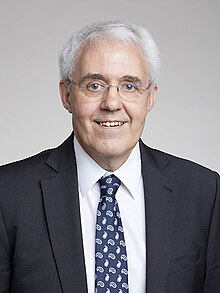Anthony Raymond Bell FRS[2] (born 9 June 1952) is a British physicist. He is a professor of physics at the University of Oxford[3] and the Rutherford Appleton Laboratory.[4] He is a senior research fellow at Somerville College, Oxford.[5]
Tony Bell | |
|---|---|
 Bell in 2017 | |
| Born | 9 June 1952 Lincoln, England |
| Education | Leeds Modern School |
| Alma mater | Churchill College, Cambridge |
| Spouse |
Irene Barnett (m. 1975) |
| Children | 3 |
| Awards |
|
| Scientific career | |
| Fields | Physics |
| Institutions | |
| Thesis | Young supernova remnants (1977) |
| Website | www2 |
Early life and education
editAnthony Raymond Bell was born on 9 June 1952 in Lincoln, England, to Raymond and Muriel Bell.[6] He was educated at Leeds Modern School and Churchill College, Cambridge, where he studied natural sciences and later gained a PhD in radio astronomy in 1977 for research investigating supernova remnants.[6][7]
Career and research
editFollowing his PhD, Bell worked on radar signal processing with Marconi Electronic Systems before moving to the Central Laser Facility as a laser-plasma theorist.[2] In 1985 he was appointed a lecturer at Imperial College London. In 2007, following two years with the Methodist Church, he was jointly appointed at the Clarendon Laboratory and the Central Laser Facility.[2]
Bell's research investigates plasma physics.[2][8][9] He wrote one of four independent papers proposing the theory of cosmic ray acceleration by shocks.[10][11][12][13] He showed how strong magnetic field is generated during particle acceleration and how it enables cosmic ray acceleration to high energy.[2] He initiated the theory of non-local transport for heat flow in inertial confinement fusion, explained the collimation of laser-produced energetic electrons by resistively generated magnetic field, and with John G. Kirk demonstrated the possibility of electron-positron pair production in ultra-high intensity laser-plasma interactions.[2]
Awards and honours
editBell was awarded the 2014 Fred Hoyle Medal and Prize of the Institute of Physics "for elucidating the origin and impact of cosmic rays and for his seminal contributions to electron energy transport in laboratory plasmas".[4] In 2016 he was awarded the Eddington Medal of the Royal Astronomical Society for "his development of the theory of the acceleration of charged particles in astrophysics, known as Diffusive Shock Acceleration".[14] He was elected a Fellow of the Royal Society (FRS) in 2017.[2] In 2021 he received the Yodh Prize of the International Union of Pure and Applied Physics (IUPAP).[15] In 2024, Bell was awarded the Royal Society's Rumford Medal[16].
Personal life
editBell married Irene Barnett in 1975; they have two sons and one daughter. He is a local preacher in the Methodist Church of Great Britain and plays the piano.[6]
References
edit- ^ "Professor Tony Bell is awarded the Hannes Alfvén Prize 2018". eps.org. Retrieved 24 August 2021.
- ^ a b c d e f g Anon (2017). "Professor Tony Bell FRS". Royal Society. Retrieved 5 May 2017. One or more of the preceding sentences incorporates text from the royalsociety.org website where:
"All text published under the heading 'Biography' on Fellow profile pages is available under Creative Commons Attribution 4.0 International License." --"Royal Society Terms, conditions and policies". Archived from the original on 11 November 2016. Retrieved 9 March 2016.
{{cite web}}: CS1 maint: bot: original URL status unknown (link) - ^ "Professor Tony Bell". University of Oxford. Archived from the original on 10 March 2017.
- ^ a b "2014 Hoyle medal and prize". iop.org. Retrieved 25 January 2016.
- ^ "Tony Bell". Somerville College, Oxford. Retrieved 1 April 2020.
- ^ a b c "Bell, Prof. Anthony Raymond, (Tony)". Who's Who. A & C Black. 2022. doi:10.1093/ww/9780199540884.013.U289274. (Subscription or UK public library membership required.)
- ^ Bell, Anthony Raymond (1977). Young Supernova Remnants. lib.cam.ac.uk (PhD thesis). University of Cambridge. OCLC 500382128. EThOS uk.bl.ethos.449440.
- ^ Tony Bell publications indexed by the Scopus bibliographic database. (subscription required)
- ^ Schawinski, K.; Justham, S.; Wolf, C.; Podsiadlowski, P.; Sullivan, M.; Steenbrugge, K. C.; Bell, T.; Roser, H.-J.; Walker, E. S.; Astier, P.; Balam, D.; Balland, C.; Carlberg, R.; Conley, A.; Fouchez, D.; Guy, J.; Hardin, D.; Hook, I.; Howell, D. A.; Pain, R.; Perrett, K.; Pritchet, C.; Regnault, N.; Yi, S. K. (2008). "Supernova Shock Breakout from a Red Supergiant". Science. 321 (5886): 223–226. arXiv:0803.3596. Bibcode:2008Sci...321..223S. doi:10.1126/science.1160456. ISSN 0036-8075. PMID 18556514. S2CID 8366768.
- ^ Bell, Anthony R. (1978). "The acceleration of cosmic rays in shock fronts – I". Monthly Notices of the Royal Astronomical Society. 182 (2): 147–156. doi:10.1093/mnras/182.2.147. ISSN 0035-8711.
- ^ Bell, Anthony R. (1978). "The acceleration of cosmic rays in shock fronts - II". Monthly Notices of the Royal Astronomical Society. 182 (3): 443–455. doi:10.1093/mnras/182.3.443. ISSN 0035-8711.
- ^ Bell, Anthony Raymond (2004). "Turbulent amplification of magnetic field and diffusive shock acceleration of cosmic rays". Monthly Notices of the Royal Astronomical Society. 353 (2): 550–558. Bibcode:2004MNRAS.353..550B. doi:10.1111/j.1365-2966.2004.08097.x. ISSN 0035-8711.
- ^ Bell, A. R.; Lucek, S. G. (2001). "Cosmic ray acceleration to very high energy through the non-linear amplification by cosmic rays of the seed magnetic field". Monthly Notices of the Royal Astronomical Society. 321 (3): 433–438. Bibcode:2001MNRAS.321..433B. doi:10.1046/j.1365-8711.2001.04063.x. ISSN 0035-8711.
- ^ "Royal Astronomical Society medals go to IOP members". 2016 News. Institute of Physics. Retrieved 25 January 2016.
- ^ "Professor Tony Bell awarded Yodh Prize". Department of Physics, University of Oxford. 1 July 2021.
- ^ "Nobel Prize-winning scientist wins Royal Society's most prestigious scientific award | Royal Society". 30 August 2024. Archived from the original on 30 August 2024. Retrieved 9 October 2024.